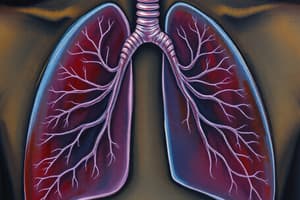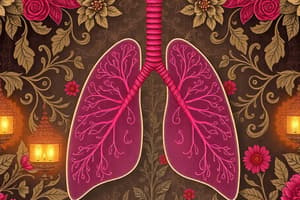Podcast
Questions and Answers
What does decreased compliance in the lungs typically indicate?
What does decreased compliance in the lungs typically indicate?
- Improved lung elasticity
- Increased tidal volume
- Enhanced respiratory rate
- Stiff lungs with restricted breathing (correct)
Which characteristic is associated with small airway obstruction?
Which characteristic is associated with small airway obstruction?
- Increased lung compliance
- Wheezing often present (correct)
- Slow ventilatory rate
- Large tidal volume
What could cyanosis indicate in a patient?
What could cyanosis indicate in a patient?
- Poor blood circulation
- Normal respiratory function
- Late response to poor oxygenation (correct)
- High oxygenation levels
What happens to the capillaries in the lungs as a person ages?
What happens to the capillaries in the lungs as a person ages?
Which process describes the movement of air into and out of the lungs?
Which process describes the movement of air into and out of the lungs?
What is a common cause of clubbing of the fingernails?
What is a common cause of clubbing of the fingernails?
Which of the following factors is NOT affected by aging in the lungs?
Which of the following factors is NOT affected by aging in the lungs?
What does perfusion specifically refer to in respiratory function?
What does perfusion specifically refer to in respiratory function?
What percentage of intravascular volume loss typically initiates hypovolemic shock?
What percentage of intravascular volume loss typically initiates hypovolemic shock?
Which symptom is NOT associated with neurogenic shock?
Which symptom is NOT associated with neurogenic shock?
Which of the following allergens is NOT commonly known to trigger anaphylactic shock?
Which of the following allergens is NOT commonly known to trigger anaphylactic shock?
What is a key progression of septic shock?
What is a key progression of septic shock?
Which type of shock is characterized by a decrease in cardiac output despite adequate intravascular volume?
Which type of shock is characterized by a decrease in cardiac output despite adequate intravascular volume?
Which symptom is NOT typical of hypovolemic shock?
Which symptom is NOT typical of hypovolemic shock?
What is a common complication that can arise with neurogenic shock?
What is a common complication that can arise with neurogenic shock?
Which of the following manifestations is associated with anaphylactic shock?
Which of the following manifestations is associated with anaphylactic shock?
What is one of the common causes of cardiogenic shock?
What is one of the common causes of cardiogenic shock?
Which of the following is a manifestation of cardiogenic shock?
Which of the following is a manifestation of cardiogenic shock?
What role does the renin-angiotensin-aldosterone system (RAAS) play in heart failure?
What role does the renin-angiotensin-aldosterone system (RAAS) play in heart failure?
Which statement regarding the RAAS system in the context of heart failure is correct?
Which statement regarding the RAAS system in the context of heart failure is correct?
Which cardiac conditions can lead to valvular dysfunction?
Which cardiac conditions can lead to valvular dysfunction?
What is a likely outcome of the RAAS system being activated in heart failure?
What is a likely outcome of the RAAS system being activated in heart failure?
In the context of heart failure, which of the following is a primary concern related to left ventricular (LV) function?
In the context of heart failure, which of the following is a primary concern related to left ventricular (LV) function?
Which of the following symptoms is NOT typically seen in cardiogenic shock?
Which of the following symptoms is NOT typically seen in cardiogenic shock?
What is characterized by the thickening of myocardium?
What is characterized by the thickening of myocardium?
What are common manifestations of left heart failure?
What are common manifestations of left heart failure?
Which factors can lead to left heart failure?
Which factors can lead to left heart failure?
What occurs in restrictive cardiomyopathy?
What occurs in restrictive cardiomyopathy?
In right heart failure, which condition may likely precede it?
In right heart failure, which condition may likely precede it?
What contributes to pulmonary vascular congestion in left heart failure?
What contributes to pulmonary vascular congestion in left heart failure?
What is a consequence of right heart failure?
What is a consequence of right heart failure?
Which symptom is typically associated with left heart failure?
Which symptom is typically associated with left heart failure?
Which of the following symptoms is NOT commonly associated with pulmonary embolus?
Which of the following symptoms is NOT commonly associated with pulmonary embolus?
Pulmonary hypertension is characterized by which of the following changes in the pulmonary arteries?
Pulmonary hypertension is characterized by which of the following changes in the pulmonary arteries?
Which of the following correctly describes hyperventilation?
Which of the following correctly describes hyperventilation?
A key factor in the development of pulmonary embolus, as outlined by the Virchow triad, does NOT include which of the following?
A key factor in the development of pulmonary embolus, as outlined by the Virchow triad, does NOT include which of the following?
In hypoventilation, which physiological condition is most likely to occur?
In hypoventilation, which physiological condition is most likely to occur?
Which risk factor is NOT associated with the development of pulmonary hypertension?
Which risk factor is NOT associated with the development of pulmonary hypertension?
The primary cause of clubbing of the fingers is often associated with which underlying condition?
The primary cause of clubbing of the fingers is often associated with which underlying condition?
Which of the following best describes the term ‘hypocapnia’?
Which of the following best describes the term ‘hypocapnia’?
Flashcards are hidden until you start studying
Study Notes
Respiratory Mechanics
- Restricted Breathing: Decreased lung compliance leads to small tidal volumes and increased respiratory rates.
- Large Airway Obstruction: Results in slow ventilatory rates but larger tidal volumes.
- Small Airway Obstruction: Characterized by rapid ventilatory rates, small tidal volumes, and often presents with wheezing.
Pain Assessment
- Pain can signal various conditions, including inflammation, trauma, pulmonary emboli, coughing, fractures, pneumothorax, or muscle pain.
- The OLDCART acronym helps explore the reasons for pain.
- Cyanosis: Indicates low oxygen levels; can be central (around mucous membranes, suggests pulmonary or cardiac issues) or peripheral (blue extremities due to stress or cold).
- Clubbing: Abnormal fingernail shape, associated with chronic conditions such as COPD or smoking history.
Aging and Lung Function
- Lung changes in older adults result from lifetime physical activity.
- Effects of aging: Decreased compliance, strength, elastic recoil, capillary networks, support structures, surface area, and increased early airway closure.
Ventilation and Perfusion Concepts
- Ventilation: Air movement in and out of the lungs, does not directly involve oxygen levels.
- Perfusion: Blood movement through lung capillaries to body tissues, primarily driven by the cardiovascular system.
- Diffusion: Gas exchange occurs between alveoli and blood, primarily involving O2 uptake and CO2 release.
Clinical Indicators of Pulmonary Disease
- Common symptoms include dyspnea, cough, abnormal sputum, hemoptysis, abnormal breathing patterns, hyper/hypoventilation, cyanosis, and clubbing.
- Pulmonary Embolus: Blockage in pulmonary circulation often from thrombus in deep veins; classic signs include tachypnea, dyspnea, and chest pain.
- Pulmonary Hypertension: Increased pressure in pulmonary arteries; risk factors include idiopathic origins, drugs, lung diseases, and left heart disease; can lead to right heart failure.
Hypoventilation vs. Hyperventilation
- Hypoventilation: Inadequate alveolar ventilation causing high CO2 levels (hypercapnia); results from mechanical or neurological issues.
- Hyperventilation: Increased alveolar ventilation leading to low CO2 levels (hypocapnia); often presents as excessive rapid breathing.
Abnormalities in Arterial Blood Gases
- Changes in ABG values can indicate various pulmonary conditions and are essential for diagnosing respiratory issues.
Types of Shock
- Hypovolemic Shock: Common type, results from significant fluid loss; signs include low blood volume symptoms (e.g., rapid heart rate, low urine output).
- Neurogenic Shock: Caused by spinal cord injury; manifests as vasodilation, hypotension, and bradycardia.
- Anaphylactic Shock: Severe allergic reaction with rapid onset; symptoms include difficulty breathing, hives, and swelling.
- Septic Shock: Progresses from infection to organ dysfunction; includes inflammation and altered tissue perfusion.
- Cardiogenic Shock: Decreased cardiac output leading to tissue hypoxia; often follows myocardial infarction and includes persistent low blood pressure.
Role of RAAS in Heart Failure
- The Renin-Angiotensin-Aldosterone System (RAAS) activates in response to low blood pressure; involves conversion of angiotensinogen to angiotensin II, which raises blood pressure and fluid retention.
- Continuous RAAS activation in heart failure exacerbates volume overload, complicating left ventricular (LV) function.
Cardiac Infections
- Valvular Dysfunction: Primarily affects mitral and aortic valves, resulting from various factors including hypertension and heart defects.
- Hypertrophic Cardiomyopathy: Thickening of the heart muscle due to increased workload; presents with angina and exertional dyspnea.
- Restrictive Cardiomyopathy: Rigid and non-compliant myocardium, leading to difficulties in ventricular filling and right heart failure.
Left vs. Right Heart Failure
- Left Heart Failure: Often caused by myocardial infarction or hypertension; leads to pulmonary congestion and presents as dyspnea, edema, and pulmonary edema signs.
- Right Heart Failure: Commonly arises from left heart failure or pulmonary disease; leads to systemic congestion and complications due to impaired right ventricular contractility.
Studying That Suits You
Use AI to generate personalized quizzes and flashcards to suit your learning preferences.




